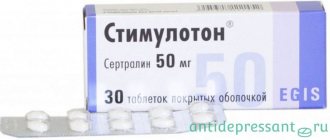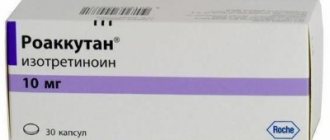pharmachologic effect
The active ingredient Quetiapine is an atypical antipsychotic or antipsychotic, a medicine for psychosis. Quetiapine and its breakdown product norketiapine affect many “nerve cell junctions,” the so-called receptors to which active substances in the nervous system bind (neurotransmitters). Neurotransmitters such as serotonin, dopamine, histamine and norepinephrine lead to changes in nerve cells due to their binding to receptors.
In addition to many other effects, these changes may also affect mood or cause hallucinations. Quetiapine also affects neurotransmitter receptors in such a way that mood can be stabilized and hallucinations subside. Norketiapine also binds to a protein that transports norepinephrine, a substance that resembles norepinephrine. This may also be the reason why quetiapine works against psychosis.
Reviews from those taking the drug
Ekaterina K .: “I have been suffering from mental illness for a long time. I tried many antipsychotics for treatment, including the predecessors of Seroquel. I came to the conclusion that this drug is indeed more effective compared to analogues. The first time I took the minimum dose at night and slept very soundly. The next day I calmly got up to work and felt great. After systematically using the medicine, my life no longer seemed gloomy, I became more assiduous and calm.”
Savely M .: “I can’t say whether this drug suited me. I have recurrent depressive disorder with frequent severe episodes. I was recently prescribed neuroleptics and it’s difficult to say how I feel about them. Seroquel has helped me cope with low mood and suicidal thoughts, but I always feel sleepy. You can take it in the hospital and it helps, but at home I can’t do anything – it makes me sleepy.”
Reviews from doctors : “Seroquel is an atypical neuroleptic of the new generation. Before the advent of drugs of this class, the issue of treating depression and productive symptoms was acute. Drugs used to treat low mood exacerbated hallucinations, and when treating schizophrenia, depression occurred. Seroquel in such cases is the drug of choice. It fights both production and depression, which is very important for some patients.”
Content
Side effects
The most common side effects reported with quetiapine are drowsiness, dizziness, dry mouth, problems with easy balance, constipation, rapid heartbeat, orthostatic hypotension, and gastrointestinal complaints.
Blood lipid levels usually increase during therapy, and liver function tests may worsen. Weight gain, fainting, decreased white blood cell counts, and some serious nervous system problems, heart rhythm problems, or bleeding problems may also occur.
Pharmacological properties of the drug Seroquel
An atypical antipsychotic drug that interacts with various types of neurotransmitter receptors. Quetiapine exhibits a higher affinity for serotonin receptors (5HT2) than for dopamine D1 and D2 receptors in the brain, as well as a high affinity for histamine and α1-adrenergic receptors and a lower affinity for α2-adrenergic receptors. It has no affinity for M-cholinergic receptors and benzodiazepine receptors, and exhibits antipsychotic activity. When studying extrapyramidal symptoms in an experiment, it was found that quetiapine causes only mild catalepsy when used in a dose that effectively blocks dopamine D2 receptors. Quetiapine causes a selective reduction in the activity of mesolimbic A10-dopaminergic neurons compared to A9-nigrostriatal motor neurons and has minimal effects on muscle tone in neuroleptic-sensitive monkeys. Quetiapine does not cause an increase in serum prolactin levels. The drug effectively eliminates both positive and negative symptoms of schizophrenia. When taken orally, it is well absorbed and actively metabolized. Food intake does not have a significant effect on the bioavailability of quetiapine. The main metabolites do not have pronounced pharmacological activity. The half-life is about 7 hours. Approximately 83% of quetiapine is bound to plasma proteins. Effective when taken 2 times a day. The effect of quetiapine on 5HT2 and D2 receptors lasts up to 12 hours, which is confirmed by positron emission tomography data. The pharmacokinetics of quetiapine is linear; there are no differences in the pharmacokinetics of the drug in men and women. The average clearance of quetiapine in elderly patients is 30–50% lower than in patients aged 18–65 years. Quetiapine clearance is reduced by 25% in patients with severe renal impairment (creatinine clearance less than 30 ml/min/1.73 m2) and in patients with liver damage (compensated alcoholic cirrhosis), but individual clearance levels are within the range corresponding to healthy people . Less than 5% of quetiapine is not metabolized and is excreted unchanged in urine or feces. Approximately 73% of quetiapine is excreted in urine and 21% in feces. The key enzyme in the metabolism of quetiapine is CYP 3A4, mediated by cytochrome P450. Quetiapine and some of its metabolites have a weak inhibitory effect on the enzymes cytochrome P450, 1A2, 2C9, 2C19, 2D6 and 3A4, but only at concentrations 10–50 times higher than the concentrations achieved when used at the usual dose (300–450 mg/day). In vitro , the ability of quetiapine to cause significant inhibition of the activity of cytochrome P450 and to influence the metabolism of other drugs mediated by it has not been established.
Drug interactions
Since quetiapine acts on the central nervous system, caution should be exercised when combining it with other medications with the same localization of action and avoid simultaneous consumption of alcohol.
Quetiapine exposure is increased by prototypical CYP3A4 inhibitors and decreased by prototypical CYP3A4 inducers.
During concomitant treatment with lithium, it is necessary to regularly determine lithium levels, since an increase in lithium levels cannot be completely excluded.
Due to its ability to cause hypotension, Seroquel XR may enhance the effects of some antihypertensive agents.
Seroquel XR may antagonize the effects of levodopa and dopamine agonists.
Analogs
An approximate list of Seroquel analogues containing the same medicinal substance:
- Quetiapine;
- Quetiapine Prolong;
- Quentiax;
- Kvetiron;
- Ketilept;
- Victoel;
- Hedonin;
- Ketiap;
- Nantharid.
The first two products on the list are named after the active substance, the rest have trade names. The differences between medications lie in the composition of the excipients, the speed of onset of the effect and the duration of action. The price of new generation drugs, including Seroquel, in pharmacies is slightly higher than their analogues.
Dosage and use of Seroquel Prolong
There is a different dosage schedule for each disease. The drug should be taken once a day. With the exception of schizophrenia, the tablets should be taken before bed. When treating schizophrenia, the medication should be taken at least an hour before meals.
The usual recommended starting dose for schizophrenia is 300 mg on day 1, 600 mg on day 2 and up to a maximum of 800 mg from day 3 onwards.
The starting dose for depressive episodes associated with bipolar disorder is 50 mg on day 1, 100 mg on day 2, 200 mg on day 3, and 300 mg on day 4 onwards. The dose may be further increased depending on response and tolerability. The maximum dose is 600 mg per day.
In the treatment of manic depression, the generally recommended starting dose is 300 mg on day 1, 600 mg on day 2, and up to a maximum of 800 mg on day 3.
The starting dose for major depressive disorder is 50 mg on days one and two, then 150 mg on day three. The dose may be further increased to a maximum of 300 mg per day depending on response and tolerability.
Indications for use
Application is justified in the following cases:
- An established diagnosis of schizophrenia, regardless of the form and severity of the disease;
- Major depressive disorder;
- Recurrent depressive disorder, severe episode of depression;
- Bipolar affective disorder, depressive or manic episode;
- Depression with a psychotic component;
- Pathologically depressed mood in organic brain diseases;
- For prophylactic purposes during remission in patients with schizophrenia or bipolar disorder, provided that treatment was carried out with the same drug.
special instructions
Seroquel should be used with caution in people with a known risk of cardiovascular and cerebrovascular disease or other conditions that make them susceptible to low blood pressure (hypotension) because, especially early on, there is a sudden drop in blood pressure with changes in position bodies.
If you suddenly stop taking the drug, withdrawal symptoms occur, so a slow reduction in the daily dose over a period of one to two weeks is recommended.
Patients with galactose intolerance, LP deficiency, or glucose-galactose malabsorption should not take this medicine.
Overdose
Increasing the dose of Seroquel increases the likelihood of side effects. Most often, signs of intoxication due to an overdose are retardation of consciousness, tachycardia, various types of heart rhythm disturbances, and a persistent decrease in blood pressure. Isolated cases of comatose states have been described when the permissible dose was exceeded several times.
The risk of life-threatening conditions increases in patients with cardiovascular and liver failure, as well as in the elderly.
There is no specific antidote. In case of an overdose of the drug, a set of standard measures is carried out: gastric lavage, enema, administration of sorbents. The patient is hospitalized in the intensive care unit.
Reviews of Seroquel
On the forums you can find various reviews of those taking the drugs Seroquel and Seroquel Prolong, as people’s opinions are divided. Some praise these medications, while others, on the contrary, speak negatively about their effectiveness and cost.
Therefore, although many patients leave positive reviews about Seroquel Prolong and Seroquel, a considerable number of patients note an extensive list of side effects, as well as a too “calm” and absolutely inactive state when using them, as a negative side of both drugs.
Contraindications
Absolute:
- children and adolescents under 18 years of age (since the safety and effectiveness of Seroquel in this age group have not been studied);
- hypersensitivity to quetiapine and/or auxiliary components of the drug.
Relative (Seroquel is used with caution):
- impaired renal and/or liver function;
- cardiovascular diseases;
- cerebrovascular diseases;
- conditions associated with the risk of increased blood pressure;
- seizures (history);
- elderly age;
- simultaneous use with drugs that prolong the QTc interval;
- simultaneous use with clarithromycin, erythromycin, azole antifungals, protease inhibitors and nefazodone;
- simultaneous use with alcohol and drugs that depress the central nervous system.
During pregnancy (and lactation)
As a rule, experts do not recommend taking both drugs during pregnancy , since the effects of quetiapine . However, in cases where the expected benefit outweighs the possible risk, drugs are used in therapeutic treatment under strict medical supervision.
While taking medications, breastfeeding should be stopped.
Release form and composition
Seroquel is available in the following forms:
- film-coated tablets, 25 mg: biconvex, round, pink, with the engraving “SEROQUEL 25” visible on one side (in blisters of 10 pieces, six blisters in a cardboard package);
- film-coated tablets, 100 mg: biconvex, round, yellow, with the engraving “SEROQUEL 100” visible on one side (in blisters of 10 pieces, six blisters in a cardboard package);
- film-coated tablets, 200 mg: biconvex, round, white, with the engraving “SEROQUEL 200” visible on one side (in blisters of 10 pieces, six blisters in a cardboard package).
The drug is also available in packages consisting of a set of tablets with different doses of the active substance: in blisters of 10 pieces, in a cardboard package one blister (6 pink tablets, 3 yellow tablets and 1 white tablet).
Composition per tablet:
- active ingredient: quetiapine – 25, 100 or 200 mg;
- auxiliary components: povidone, calcium hydrogen phosphate, microcrystalline cellulose, sodium carboxymethyl starch, lactose monohydrate, magnesium stearate;
- film coating: titanium dioxide, macrogol 400, red iron oxide dye (pink tablets), hypromellose, yellow iron oxide dye (pink and yellow tablets).
Seroquel price, where to buy
You can buy both drugs in pharmacies with a doctor's prescription. It is worth noting that these drugs are not cheap, for example, the average price of Seroquel Prolonga 300 mg. (60 tablets in one package) reaches 1100 rubles.
- Online pharmacies in RussiaRussia
- Online pharmacies in UkraineUkraine
LuxPharma* special offer
- Seroquel Prolong tablet.
400 mg No. 60 RUR 10,500 order
ZdravCity
- Seroquel tab. p.p.o. 100 mg n60AstraZeneca Pharmaceutical Co., Ltd./AstraZeneca UK Limited
1170 rub. order
- Seroquel tab. p.p.o. 200 mg n60AstraZeneca Pharmaceutical Co., Ltd./AstraZeneca UK Limited
RUR 2,001 order
- Seroquel tab. p.p.o. 25mg n60AstraZeneca Pharmaceutical Co., Ltd./AstraZeneca UK Limited
RUR 941 order
Pharmacy Dialogue
- Seroquel (tablet p/o 100 mg No. 60)Astra Zeneca/ZIO Zdorovye
RUB 1,155 order
- Seroquel (tablet p/o 200 mg No. 60)Astra Zeneca/ZIO Zdorovye
RUB 1,968 order
- Seroquel (tablet p/o 25 mg No. 60)Astra Zeneca/ZIO Zdorovye
RUR 975 order
show more
Pharmacy24
- Seroquel XR 50 mg No. 60 tablets Astra Zeneca UK Limited, UK
810 UAH.order - Seroquel XR 200 mg N60 tablets Astra Zeneca UK Limited, UK
1579 UAH. order










